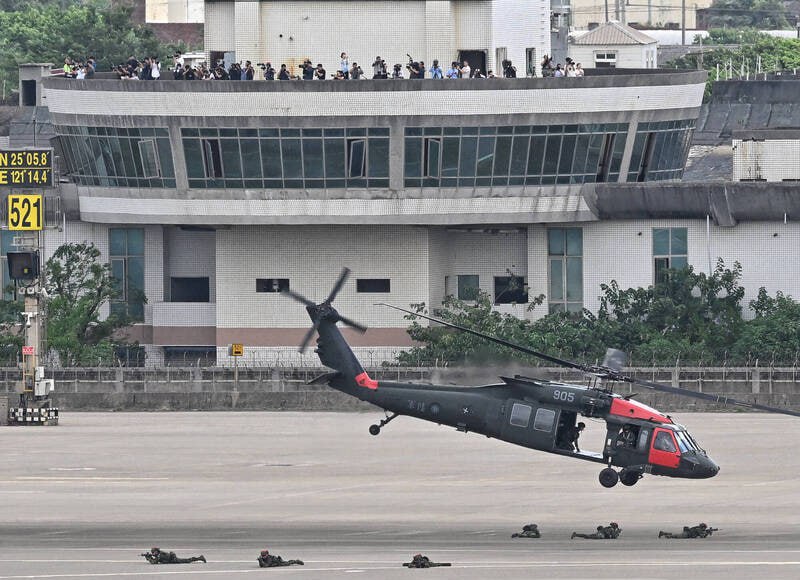The Taiwanese military practiced defending against an attack on its largest airport from the Chinese People’s Liberation Army (PLA) as a part of its massive annual Han Kuang exercises.
Cheaper & Readily Available, South Korea’s K239 Chunmoo MLRS Is Giving HIMARS A Run For Its Money
Experts said the Russian operation inspired the Taiwanese drill to take the Gostomel (Hostomel) airport in Ukraine in the early days of the war in February 2022.
Taipei anticipates a similar thinking on the Chinese operational planning and believes Beijing will try and cut off all connectivity, sea and air, to the island when it executes the blockade.
The Han Kuang are Taiwan’s largest military exercises with a different emphasis each year on a new area of military operations.
This time, the military preparations have been the most concerted, determined, and comprehensive at an unprecedented scale since China enhanced its military activities around the island like never before following former US Speaker Nancy Pelosi’s visit to the island in August 2022.
The particular focus this time has been on amphibious and beach defense operations to fend off a Chinese amphibious landing. Previous assessments have shown China would be willing to undertake a politically costly ground and urban warfare operation in Taiwanese cities.
This is if the Taiwanese leadership does not cave into the coercive and psychologically overwhelming military encirclement of Taiwan and cave into Chinese demands.
Drill At Largest Airport After Lessons From Ukraine
This first-ever military drill took place at Taoyuan International Airport on Wednesday and briefly halted commercial traffic. This is the first such drill held at Taiwan’s biggest airport since it opened in 1979.
AP quoted military expert Alexander Huang saying Taiwan was drawing from Ukraine’s experience when it fended off an attack by Russian paratroopers at the Gostomel (or Hostomel or Antonov airport) just outside Kyiv. The battle at the airport saw the destruction of the An-225 Mriya, the world’s largest commercial cargo aircraft.
“Seizing an adversary’s airport is key to sending in large numbers of assault forces via air transport in an invasion attempt,” Huang said at Taipei’s Tamkang University. “In addition to familiarizing our forces with command and control, this drill can signal potential enemies that we are getting ourselves prepared for such contingency,” Huang said.

Taiwanese soldiers on the ground fought off dozens of attackers who assaulted the airport under the cover of attack helicopters, parachutes, and ground assault. Pictures showed Taiwanese special operations troops acting as the attacking red forces landing helicopter-borne troops from UH-60 Black Hawk choppers on the airside and tarmac.
Similar exercises carried out on July 19 supporting the main Han Kuang drills also had ‘red forces’ landing 24 special operations troops at the airport runway while receiving support from two AH-64 Apache attack helicopters. These can be assumed to imitate the role of China’s Z-10 attack helicopters.
“The Apaches entered at low altitude and simulated attacks on designated targets in the airport area. At the same time, the commandos made a landing and launched an offensive, capturing key objects,” said a description of the attack by a leading defense affairs blog on Weibo.
Airport police and firefighters joined the operations in a combined civil-military team that protected key civilian infrastructure. In general, this year’s Han Kuang drills also have a greater civilian component, where local governments in various Taiwanese cities hold air-raid drills.
A drill was also initially scheduled at an airport in Taiwan’s southeast in Taitung but was canceled due to Typhoon Doksuri.
Russia’s Partially Successful Gostomel Operation
The Russian forces held the Gostomel airport for over a month from February 24, when it commenced its Special Military Operation (SMO), until April 2, when Russia withdrew, ceding control to the Ukrainians.
While suffering numerous losses and committing several tactical mistakes that saw certain locations around the airport changing hands multiple times, the Russian withdrawal from the airport was a part of the larger withdrawal from the Kyiv axis where the ground maneuver and massive military convoy outside the city to take the capital was abandoned.
However, several Western observers later assessed that the move on Kyiv had been a feint to force Ukraine to concentrate its forces in the north so that Russia could make some gains and “shape the battlefield” in the east and the south.
Regardless, the assault at the airport with airborne troops with nearly 300 helicopters, including Ka-52 Alligators and troops from the various Air Assault Brigades, was largely successful.
CNN described the airport’s fall as “the first major victory notched by the Russians” in the invasion. The Washington Post also stated that “still, the Russians had their bridgehead” after capturing the airport. The attack with the landing force failed to secure the airport to call in aerial reinforcements and prevent a Ukrainian counterattack.
- The author can be reached at satamp@gmail.com
- Follow EurAsian Times on Google News